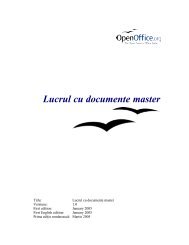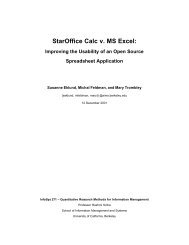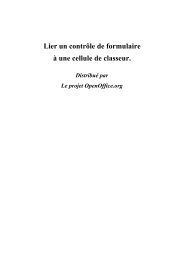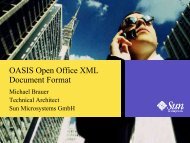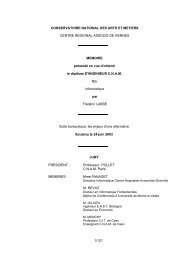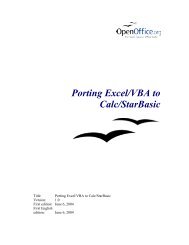The Microsoft Excel File Format - OpenOffice.org
The Microsoft Excel File Format - OpenOffice.org
The Microsoft Excel File Format - OpenOffice.org
You also want an ePaper? Increase the reach of your titles
YUMPU automatically turns print PDFs into web optimized ePapers that Google loves.
5 Worksheet/Workbook Records<br />
5.55 HEADER<br />
BIFF2 BIFF3 BIFF4 BIFF5 BIFF8<br />
0014 H 0014 H 0014 H 0014 H 0014 H<br />
This record is part of the Page Settings Block (➜4.4). It specifies the page header string for the current worksheet. If this<br />
record is not present or completely empty (record size is 0), the sheet does not contain a page header.<br />
Record HEADER for non-empty page header, BIFF2-BIFF8:<br />
Offset Size Contents<br />
0 var. Page header string<br />
BIFF2-BIFF5:<br />
BIFF8:<br />
Non-empty byte string, 8-bit string length (➜2.5.2)<br />
Non-empty Unicode string, 16-bit string length (➜2.5.3)<br />
<strong>The</strong> header string may contain special commands, for example placeholders for the page number, current date, or text<br />
formatting attributes. <strong>The</strong>se fields are represented by single letters (exception: font name and size, see below) with a<br />
leading ampersand (“&”). If the ampersand is part of the regular header text, it will be duplicated (“&&”).<br />
<strong>The</strong> page header is divided into 3 sections: the left, the centred, and the right section. Each section is introduced by a<br />
special command. All text and all commands following are part of the selected section. Each section starts with the text<br />
formatting specified in the default font (first FONT record in the file). Active formatting attributes from a previous<br />
section do not go into the next section.<br />
<strong>The</strong> following table shows all available commands:<br />
Command Contents Command Contents<br />
&& <strong>The</strong> “&” character itself<br />
&L<br />
&C<br />
&R<br />
Start of the left section<br />
Start of the centred section<br />
Start of the right section<br />
&P Current page number &A Sheet name (BIFF5-BIFF8)<br />
&N Page count &F <strong>File</strong> name without path<br />
&D Current date &Z <strong>File</strong> path without file name (BIFF8)<br />
&T Current time &G Picture (BIFF8)<br />
&B Bold on/off &H Shadowed text on/off<br />
&I Italic on/off &O Outlined text on/off<br />
&U Underlining on/off &X Superscript on/off (BIFF5-BIFF8)<br />
&E Double underlining on/off (BIFF5-BIFF8) &Y Subscript on/off (BIFF5-BIFF8)<br />
&S<br />
Strikeout on/off<br />
More complex commands:<br />
!<br />
Command<br />
&""<br />
&","<br />
&<br />
Contents<br />
Set new font <br />
Set new font with specified style . <strong>The</strong> style is in most cases<br />
one of “Regular”, “Bold”, “Italic”, or “Bold Italic”. But this setting is dependent on the<br />
used font, it may differ (localised style names, or “Standard”, “Oblique”, ...). (BIFF5-<br />
BIFF8)<br />
Set font height in points ( is a decimal value). If this command is followed<br />
by a plain number to be printed in the header, it will be separated from the font height<br />
with a space character.<br />
In BIFF2 the commands differ in the localised versions of <strong>Excel</strong>.<br />
180





